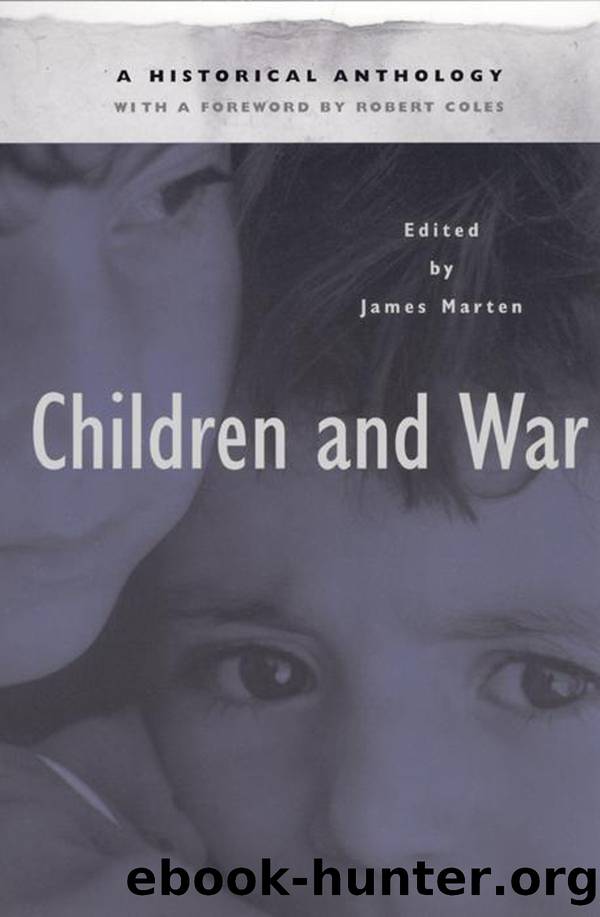Children and War by Marten James; Coles Robert;

Author:Marten, James; Coles, Robert;
Language: eng
Format: epub
Publisher: New York University Press
Published: 2002-09-14T16:00:00+00:00
Conclusion and Epilogue
This chapter has shown how the postrevolutionary Mexican state reconciled its bloody and divisive genesis by appropriating the revolution and refashioning peasant heroes through the SEP. Cult heroes in life, Villa and Zapata became even larger in death. Ironically, their legacies were appropriated by the very regime that killed them. Revolutionary nationalism remains a potent legacy in modern Mexico, even as the PRI and the PAN have tried to distance themselves from this legacy in recent years. Mexican schoolchildren may have learned the lessons of revolutionary nationalism contained in SEP classrooms and textbooks, but the PRI had no control over how angry university students, peasants, schoolteachers, and insurgents would appropriate these lessons in later years.
Revolutionary nationalism, disseminated by the SEP and its teachers, helped Mexico’s former ruling party remain in power for seventy-one consecutive years. Ironically, it was a guerrilla group using the symbols of revolutionary nationalism that posed the most potent challenge to the PRI in the 1990s. On July 2, 2000, Vicente Fox of the PAN defeated the PRI’s candidate for president and broke the former ruling party’s monopoly on political power. At the time this manuscript went to press, the full ramifications of this change were still being measured and many questions remained. How will the PAN change the way that the revolution is taught? As Mexico’s political system becomes more plural, it becomes harder for the SEP to impose on Mexican schoolchildren a single, unifying version of Mexican history. And what will happen to the revolution’s popular heroes? Agrarian reform is dead, and the pro-business PAN has little use for Villa and Zapata. The free textbook program may also be in serious jeopardy. The SEP, now directed by the PAN, is likely to favor the privatization and decentralization of school textbooks on ideological grounds. In many states other books are already used in lieu of the SEP’s free textbooks; it is further estimated that more than half of Mexico’s rural schools nationwide do not use the books. Finally, because revolutionary nationalism became so closely associated with the PRI, the “Party of the Institutional Revolution,” the PAN may wish to let it fade in the collective conscience. The PAN, after all, claims to represent change and a break from the past. In all likelihood, the utopian attempt to impose a single, unifying version of Mexican history in the classroom—always a dubious and controversial enterprise—will likely succumb to SEP decentralization, the PAN’s penchant for privatization, the growing plurality of Mexican society, and the fact that revolutionary nationalism is considered the anachronistic relic of the erstwhile “heir to the Revolution,” the PRI.29
Download
This site does not store any files on its server. We only index and link to content provided by other sites. Please contact the content providers to delete copyright contents if any and email us, we'll remove relevant links or contents immediately.
| Africa | Americas |
| Arctic & Antarctica | Asia |
| Australia & Oceania | Europe |
| Middle East | Russia |
| United States | World |
| Ancient Civilizations | Military |
| Historical Study & Educational Resources |
Magic and Divination in Early Islam by Emilie Savage-Smith;(1500)
Ambition and Desire: The Dangerous Life of Josephine Bonaparte by Kate Williams(1346)
Bohemians, Bootleggers, Flappers, and Swells: The Best of Early Vanity Fair by Bohemians Bootleggers Flappers & Swells- The Best of Early Vanity Fair (epub)(1344)
Papillon by Henry Charrière(1310)
Twelve Caesars by Mary Beard(1258)
Operation Vengeance: The Astonishing Aerial Ambush That Changed World War II by Dan Hampton(1137)
What Really Happened: The Death of Hitler by Robert J. Hutchinson(1131)
London in the Twentieth Century by Jerry White(1114)
Time of the Magicians by Wolfram Eilenberger(1089)
The Japanese by Christopher Harding(1086)
Twilight of the Gods by Ian W. Toll(1084)
Lenin: A Biography by Robert Service(1045)
The Devil You Know by Charles M. Blow(985)
A Social History of the Media by Peter Burke & Peter Burke(938)
Freemasons for Dummies by Hodapp Christopher;(923)
Napolean Hill Collection by Napoleon Hill(904)
Henry III by David Carpenter;(892)
The Churchill Complex by Ian Buruma(884)
The Rise and Triumph of the Modern Self by Unknown(880)
